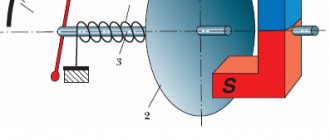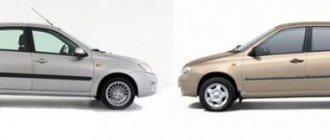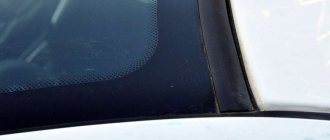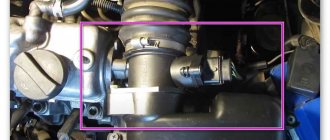There are four main models of the Lada Kalina passenger car:
- sedan - has a closed body, with 2-3 rows of seats for the driver and passengers, the trunk is separated from the car interior, there is no lifting door in the rear wall;
- station wagon - has a closed cargo-passenger body, one of the sedan variants, which has an enlarged luggage compartment, is equipped with a lifting door in the rear wall;
- hatchback - has a body with 1-2 rows of driver and passenger seats, with a shortened rear overhang (hence the name - “hatchback” means “short”) and a smaller luggage compartment, equipped with a lift-up door in the rear wall;
- sport - is a sports version, which is equipped with a number of special parts - a bumper, an exhaust pipe tip, sports pedals, alloy wheels, a SAAZ Sport sports suspension, front and rear disc brakes, an original reinforced gearbox.
As you can see, the main difference between each model is its body type. Gasoline consumption (unleaded AI-95) is calculated in liters over a driving cycle, which is 100 kilometers.
In this case, the following parameters of the vehicle itself are taken into account:
- Engine size (Lada Kalina comes in two types - 1.4 l and 1.6 l).
- Number of valves (for Lada Kalina - 8 and 16).
Experts have prepared an information table that shows the factory fuel consumption indicators for each model of the Lada Kalina passenger car, taking into account the mandatory parameters.
Model Lada Kalina
1.6 l (8 valves)
The manufacturer sets the standards for digital fuel consumption indicators for each Lada Kalina model based on the results of test runs of passenger cars on a special track. But on the track, driving conditions are reduced to ideal, and the car is driven by an experienced driver. In real conditions, everything becomes much more complicated. In addition, the speed indicator during real driving is not always within the required limits - from 100 km/h to 120 km/h. This is due to the fact that some drivers do not recognize the established framework for optimal driving of a Lada Kalina car, which significantly affects fuel costs.
Lada Kalina 2004 - 2013
First cars
The first production sedan was equipped with a 1.6-liter eight-valve engine. The production of this engine was well tested and familiar. It almost completely, with minor improvements, repeated the design of the power unit of the VAZ G8, but only its volume increased. Power 82 hp enough to complete the assigned tasks - driving in city traffic and driving on the highway at the speed allowed in Russia.
New bodies and engines
Since 2006, cars with a hatchback body began to roll off the assembly line, and in 2007 a station wagon appeared. The evolution of power units was continued by a motor with the same volume, but with a 16-valve mechanism. The car's power has increased, and so has its acceleration dynamics. Unfortunately, the fuel consumption of the Lada Kalina often exceeded the figures stated by the manufacturer. They tried to reduce it by reducing the engine volume from 1.6 to 1.4 liters. Power dropped by 20 hp. s., but the new engine actually consumed less gasoline.
Gearbox and features of the first generation
All Kalinas until 2013 were equipped with a 5-speed manual transmission. The fuel injection and ignition processes are controlled electronically. During its release, the model acquired an anti-lock brake system, electric power steering and air conditioning, which was installed on upgraded cars.
Fuel consumption depending on engine
- The 8-valve engine with 1600 cc capacity is characterized by low power but excellent torque. When the load increases, there is often no need to downshift. The advantage is that damage to the timing belt will not cause the valves to collide with the pistons, and they will not be deformed. The downside is that it is noisy during operation. When driving on the highway at a speed of 90 km/h, the claimed consumption is 5.5 liters per 100 km.
- The 1.6-liter power unit, equipped with sixteen valves, is significantly more powerful than its predecessor, but its thrust has decreased. It is more capricious in terms of fuel and oil, its maintenance and repairs are more expensive. True, it also consumes less gasoline: according to the manufacturer, consumption on the highway is about 5 liters, in the city - 7 liters, mixed - 6 liters. The actual figures are slightly higher. The main reason for greater efficiency with increased power is better efficiency when consuming the fuel-air mixture, faster fuel supply to the cylinder and exhaust gas output.
- The most economical is the smaller engine with 16 valves. The revolutions have increased to 4.5 thousand per minute, but driving with a load in high gear is unlikely to be possible. If the timing belt breaks, there is a risk of bending the valves, and this will affect the cost of repairs.
| Modification | 1.6, 8 grades, 5 grades. Manual transmission | 1.6, 16 grades, 5 grades Manual transmission | 1.4, 16 grades, 5 grades Manual transmission |
| Consumption city, l/100 km | 7,7 | 9,8 | 8,5 |
| Route, l/100 km | 5,5 | 6 | 5,5 |
| Combined cycle consumption, l/100 km | 7,5 | 7,2 | 7,5 |
| Acceleration, sec up to 100 km/h | 13,5 | 12 | 12,5 |
see also
Comments 29
So now are the spark plugs good or not?)) Will they fit my Audi?)
The tests were completed long ago and the experiment was forgotten, so it’s up to everyone to decide for themselves, but to be honest, I gave up on this matter and installed HBO)))
Poor motor. Have you tried simply refueling with the correct fuel (according to your passport)? Religion doesn't allow it?
The new bullies are much better. The engine runs more stable at any speed. And as they say, they last longer. And visually they are much better quality
I remember seeing a table where the maximum occurred at 23 ml per 10 liters of gasoline
The candles work with delayed ignition and a lean mixture. These spark plugs are simply a miracle - but with a mediocre approach and ignorance of the process of igniting the mixture with them, the result will be minimal or there will be no result at all. My best result is 179 km on ten liters of gas in urban mode. The car is a VAZ 21043. Naturally, I wanted even more and with my next efforts I spoiled the result. Although the consumption and dynamics are excellent, I did not achieve more such consumption.
I agree, this is the result I was looking for. But then it got worse because of the quality of the gasoline. Currently 8.6 l/100 in the city.
It works well on all VAZs, because... the chamber is cleaned, but the issue is not only in the chamber, but rather in the condition of the engine as a system. For those VAZs on which I put only positive reviews, about the dynamics almost always, and about the consumption the decrease ranged from 10 to 30%.
Regarding the research, we contacted them and came for testing. as a result: 1. We provided candles 2. We had to carry out tests together in the laboratory BUT... We were simply not allowed into the laboratory, and after the tests, their employees were forbidden to even talk to us. When asked about the agreements, we were told that we carried out the tests as agreed, but there was no report. They later gave a report, but it was just a formal reply. And then they explicitly hinted, “Give me the money” and we will announce the real results, but we didn’t have the money for that. With us, everything is based on enthusiasm. I buy with my own money and tell people what and how. The candles are made in China, but according to our order. However, the order is not always fulfilled in the form required. With the last batch we had a puncture. The “skirt” was not made as it should; as a result, the candles we ordered turned out to be technologically defective. Those. at speeds of 120 km/h. and higher, the skirt may burn, because does not fit tightly to the candle. Of the 50 sets that I bought with my own money, 30 were defective. I sell them, but I warn you that this is how it is. In the end, it turned out that we were simply bankrupt. For the time being, until we find money for a new order or investors.
ps Sorry for being off topic. it just boiled over. If you have any questions, write in a personal message.
What is there to investigate, I screwed it in and the internal combustion engine is immediately quieter... The problem is quality - the insulator lets gases through over time, but this is for an internal combustion engine with a compression ratio of more than 8.5... I have never seen spark plugs in an internal combustion engine 2101-07 where they leak in the place where the ceramics let through...
in general I filled in more











